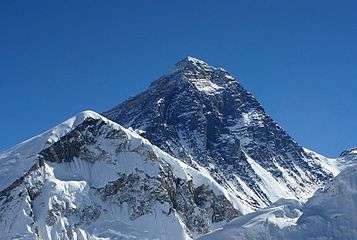South Summit (Mount Everest)
| Mount Everest South Summit | |
|---|---|
|
Mount Everest. The raised, slightly lower peak directly to the right of the summit is the South Summit. | |
| Highest point | |
| Elevation | 8,749 m (28,704 ft) |
| Prominence | 11 m (36 ft) |
| Isolation | 0.36 km (0.22 mi) |
| Parent peak | Mount Everest |
| Listing | Eight-thousanders |
| Coordinates | 27°59′6″N 86°55′33″E / 27.98500°N 86.92583°ECoordinates: 27°59′6″N 86°55′33″E / 27.98500°N 86.92583°E |
| Geography | |
 Mount Everest South Summit Mount Everest, Solukhumbu District, Sagarmatha Zone, Nepal; | |
| Parent range | Mahalangur Himal, Himalayas |
| Climbing | |
| First ascent | May 26, 1953[1][2] |
| Normal route | Traversing the South Col |
The South Summit of Mount Everest is the second-highest peak on Earth, and is a subsidiary peak to the primary peak of Mount Everest. Although its elevation above sea level of 8,749 metres (28,704 ft) is actually higher than the second-highest mountain on Earth, K2 (whose summit is 8,611 metres (28,251 ft) above sea level), it is only considered a separate peak and not a separate mountain as its prominence is only 11 meters.
The peak is a dome-shaped peak of snow and ice, and is connected to the summit of Mount Everest by the Cornice Traverse and Hillary Step. It was first climbed by Charles Evans and Tom Bourdillon on the 1953 British Mount Everest expedition, on May 26, 1953.[1][2] They were unable to continue on to the primary summit, but Edmund Hillary and Tenzing Norgay, the next pair to make a summit bid, traversed the South Summit to reach the main peak. The distance separating the two summits is approximately 130 metres (430 ft).
A geologist with a 1965 Indian Everest expedition discovered a deposit of fossils of seashells in limestone about 100 feet above the South Summit. This expedition put nine climbers on the main summit. [3]
Describing his first ascent of Mount Everest without supplemental oxygen in 1978, Reinhold Messner described the South Summit as "quite a milestone for me".[4]
During the 1996 Mount Everest disaster, mountain guide Rob Hall and three other people died at the South Summit while descending from the main summit in an unexpected blizzard. Hall survived overnight, and established radio contact the following day, but froze to death later that day, May 11, 1996. His body remains on the South Summit.[5][6]
In 2012 Dr. Eberhard Schaaf died on descent at the south summit from altitude sickness.[7]
See also
References
- 1 2 Isserman, Maurice; Weaver, Stewart (2010). Fallen Giants: A History of Himalayan Mountaineering from the Age of Empire to the Age of Extremes. Yale University Press. pp. 286–287. ISBN 9780300164206.
- 1 2 Kerr, Jim (2008). Hillary and Norgay's Mount Everest Adventure: Great journeys across earth. Heinemann-Raintree Library. p. 45. ISBN 9781403497550.
- ↑ Kohli, Mohan Singh (2000). Nine Atop Everest: Spectacular Indian Ascent. New Delhi: Indus Publishing. pp. 168–169. ISBN 9788173871115.
- ↑ Messner, Reinhold (1979). Everest: Expedition to the Ultimate. Kaye & Ward. ISBN 9780195201352.
- ↑ Boukreev, Anatoli; DeWalt, G. Weston (2015). The Climb: Tragic Ambitions on Everest. St. Martin's Griffin. p. 199. ISBN 9781250099822.
- ↑ Simpson, Joe (1999). Dark Shadows Falling. The Mountaineers Books. pp. 33–40. ISBN 9780898865905.
- ↑ Billera, Michael (17 February 2010). "Three Climbers Reported Dead Scaling Mount Everest: Eberhard Schaaf, Shriya Shah, and Song Won-bin Dead, Two Others Missing". Ibtimes.com. Retrieved 17 June 2016.

